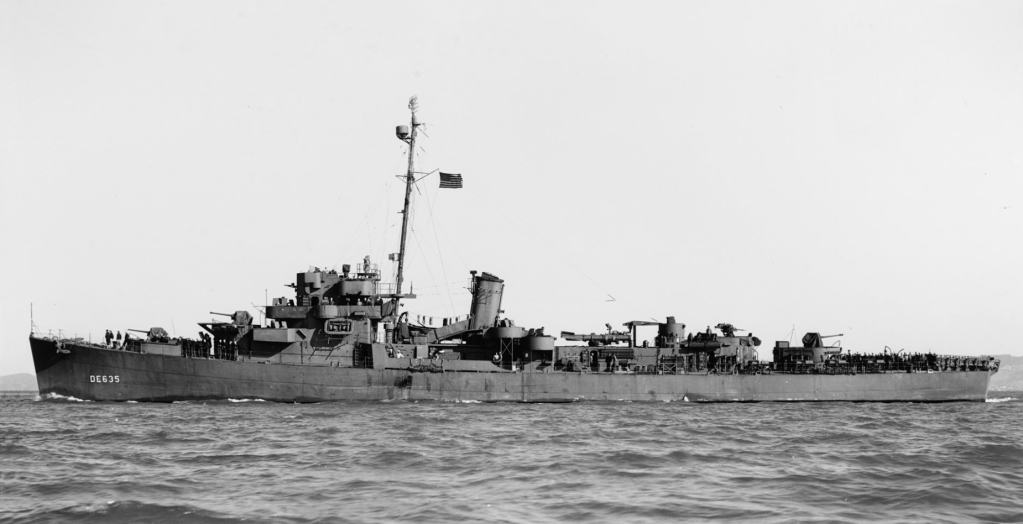Sometimes there can be total domination by an individual or a team. In sports, we could see it in something like Gayle Sayers scoring six touchdowns in a game, or Randy Johnson pitching a perfect game. In war, it can be racking up a lot of kills in quick succession, like Chuck Yeager’s becoming an “ace in a day.” So here is the rarely-told story of how one destroyer escort, the USS England (DE 635), pulled off utter dominance in anti-submarine warfare – six kills in less than two weeks.
The famed Second Support Group lead by Frederick J. Walker of HMS Starling in its best stretch took 19 days to get six kills (31 January, 1944 to 19 February, 1944).
USS England was a Buckley-class destroyer escort, displacing 1,400 tons with a top speed of 23 knots, and was armed with three 3-inch guns; a quad 1.1-inch gun; some small anti-aircraft guns; three 21-inch torpedo tubes; a “Hedgehog” anti-submarine mortar; and a number of depth charge launchers. This was a potent arsenal against aircraft, surface vessels and submarines.
Here are the reasons why the USS England was a Japanese sub’s worst nightmare during World War II
Kill One – 18 May, 1944
The USS England was operating with two sister ships, the USS George (DE-697) and the USS Raby (DE-698) when she was ordered to intercept the Japanese submarine I-16. Navy codebreakers had cracked a message that I-16 was delivering supplies to Japanese troops. The England made five attacks using the Hedgehog and scored the kill.
Kill Two – 22 May, 1944
Again, Navy codebreakers provided information on Japanese intentions. This time, they sent a line of subs to sit astride a route that Adm. Bill Halsey had used to move the Third Fleet on two previous occasions. The USS George first detected the Japanese submarine RO-106 at 3:50 AM local time on May 22, but missed. Less than an hour later, the USS England fired the first salvo of Hedgehogs and missed. But at 5:01, the England’s second salvo scored hits that triggered an explosion.

Kill Three – 23 May, 1944
After scoring that kill, the three destroyer escorts began scouting for the rest of the line. The next day, the American vessels found the Japanese RO-104. The USS Raby and USS George missed with eight Hedgehog attacks over two hours, starting at 6:17 in the morning. The USS England then took over, scoring on her second attack at 8:34 AM.
Kill Four – 24 May, 1944
The American destroyer escorts continued their sweep up the Japanese submarine picket line. A half-hour later, the England made sonar contact, and after 24 minutes, launched a Hedgehog attack, putting the Japanese sub RO-116 on the bottom.
Kill Five – 26 May, 1944
Eventually a hunter-killer group consisting of the Casablanca-class escort carrier USS Hoggatt Bay (CVE 75) and the Fletcher-class destroyers USS Hazelwood (DD 531), USS Heerman (DD 532), USS Hoel (DD 533), and USS McCord (DD 534) relieved the three destroyer escorts. The escorts maintained their search formation, and came across the RO-108. USS England picked up the target at 11:04 PM, then launched an attack with Hedgehogs, scoring direct hits on her first salvo.
Kill Six – 31 May, 1944
After re-supplying, the three destroyer escorts were joined by the USS Spangler (DE-696), another Buckley-class destroyer escort. They re-joined the Hoggatt Bay hunter-killer group, and continued their mission. On May 30, the hunt began when USS Hazelwood picked up the RO-105 on radar at 1:56 AM. Commander Hamilton Hains, the escort commander, ordered England to hold back. A depth-charge attack failed, leading to a lethal 25-hour game of cat and mouse during which over 20 hedgehog attacks missed. Finally, Hains sent the England in. One salvo of hedgehog later, RO-105 was on the bottom of the Pacific.

Rear Adm. Samuel Eliot Morison wrote that Hains later sent a message to USS England, asking “God damn it, how do you do it?”
The response from Cmdr. C.A. Thorwall, the CO of Destroyer Escort Division 40, who has his flag on board USS England, was both witty and politically incorrect.
“Personnel and equipment worked with the smoothness of well-oiled clockwork. As a result of our efforts, Recording Angel working overtime checking in [Japanese] submariners joining Honorable Ancestors,” Morrison was quoted as saying in Volume VIII of his History of United States Naval Operations of World War II.
Admiral Ernest J. King vowed, “There will always be an England in the United States Navy.”
After her exploits, the USS England carried out escort missions. She would not see much more action until May 9, 1945, when she was attacked by three dive bombers. England shot one down, but the plane crashed into her, forcing the ship to return to the United States for repairs.
The end of World War II lead to the ship’s decommissioning the month after Japan surrendered. And she was sold for scrap in 1946.
In 1963, a Leahy-class destroyer leader was named USS England (DLG 22). Later re-designated a cruiser, this ship served in the Navy until being decommissioned in 1994, and sold for scrap 10 years later.
To date, there are no ships currently in service or under construction with the name USS England.
-Feature image: US Navy photo


